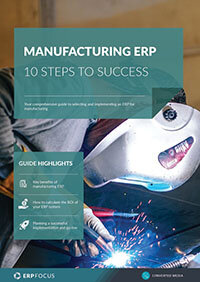How to use ERP workflow to improve supply chain management
ERP workflows are kind of like a digital SOP, linking each step in your process as connected ERP transactions. By enforcing these linked transactions, you eliminate errors from disconnected tasks and ensure every change in one area automatically updates the next, boosting both ERP and supply chain management efficiency.
Purchase order management workflow
A supply chain workflow often centers on purchase order (PO) management. Traditionally, a buyer spots demand from a sales order or forecast and places a PO just ahead of the lead time.
The PO remains open until the material arrives and is received into inventory. If delivery runs late, you may resort to expediting, but that reactive approach wastes time and margin.
With an ERP workflow, you automate reminders after PO release. You receive an acknowledgement automatically, and you expect an advance shipping notice (ASN) before delivery. If any step slips, the system alerts the buyer so they can intervene immediately.
Recommended reading: Manufacturing ERP - Select the right ERP for supply chain management success
When demand shifts (say, someone enters a rush sales order inside the lead time), the ERP marks that sales order “pending approval” and alerts sales and material teams at once. That real-time collaboration settles issues before they snowball into production delays.
Production scheduling workflow
Similarly, suppose a production planner attempts to release a work order off the approved schedule. In that case, the ERP workflow blocks the change, stopping order processing or time-charging until a manager reviews it. Automated alerts go to both production and material planners so they can resolve the conflict before it affects your entire schedule.
Supplier-receiver workflow
ERP workflows extend across organizational boundaries, too. If your supplier acknowledges a PO but proposes a later delivery date, the system flags that mismatch.
The buyer sees the issue at once, and the ERP triggers notifications to the demand owner. You then adjust orders, shift production, or onboard an alternative supplier, all before any orders slip through the cracks.
Integrating ERP, SCM, and CRM software
A key part of ERP software is supply chain management, but its true potential shows when you combine it with CRM and other systems.
By integrating ERP, SCM, and CRM, you create a single source of truth for customer demand, order status, and inventory levels. This streamlines handoffs from sales to purchasing, production, and back to customer service.
Free white paper

Manufacturing ERP: 10 steps to success
Complete step-by-step guide to manufacturing ERP software

Related articles
-

5 Ways ERP Forecasting Can Improve Business Efficiency
Read about 5 areas of your business which can be dramatically improved through ERP forecasting.
-

Secret KPI: Why Your ERP Implementation Team Matters More Than Software
Learn how Godlan ensures successful ERP implementation for manufacturers with proven strategies &...
-

ERP & Logistics: Optimizing the Supply Chain
Read about the steps you can take to optimize your supply chain through ERP software logistics ma...

